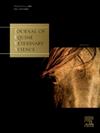Agreement between subjective evaluations and a markerless AI-based gait analysis system during lungeing assessment in traditional racehorses
IF 1.6
3区 农林科学
Q2 VETERINARY SCIENCES
引用次数: 0
Abstract
Background
Subjective lameness evaluation during lungeing is routinely performed in equine practice, but its consistency remains limited, especially in cases of mild or complex asymmetry.
Aims
This study aimed to assess the agreement between subjective gait evaluations and a markerless AI-based gait analysis system (OAI-MS) in traditional racehorses during lungeing. Intra- and inter-observer agreement of subjective evaluations was also investigated.
Methods
24 traditional racehorses were assessed during routine pre-race inspections (T0) while trotting on a soft surface. Two experienced equine clinicians independently evaluated each horse on both reins using the AAEP 0–5 scale; scores were then converted to a 3-level ordinal scale (0 = sound, 1 = mild, 2 = severe). Simultaneously, gait data were collected using the OAI-MS. A subset of 10 horses was re-evaluated after 10 days (T1) to assess short-term repeatability of the OAI-MS. Video-based reassessment (T2) was used to evaluate intra-observer agreement. Agreement was calculated using weighted Cohen’s and Fleiss’ kappa. p < 0.05.
Results
Inter-observer agreement ranged from κ = –0.20 to 0.36. Agreement between subjective evaluators and the OAI-MS ranged from slight to moderate (κ = 0.13–0.47). Intra-observer agreement was fair (κ ≈ 0.22), and OAI-MS repeatability reached κ = 0.43. Agreement was higher for forelimbs than hindlimbs. Most discrepancies were of low magnitude.
Conclusion
Subjective gait evaluations during lungeing showed limited agreement. The OAI-MS demonstrated moderate repeatability, supporting its usability in the field and its potential role as a complementary tool in clinical decision-making, particularly when asymmetries are mild or disagreement occurs.
传统赛马冲刺评估中主观评价与无标记人工智能步态分析系统的一致性。
背景:主观跛行评估在弓步练习中是常规的,但其一致性仍然有限,特别是在轻度或复杂不对称的情况下。目的:本研究旨在评估传统赛马在冲刺过程中主观步态评估与基于无标记人工智能的步态分析系统(OAI-MS)的一致性。还调查了主观评价的观察者内部和观察者之间的一致性。方法:对24匹传统赛马进行常规赛前检查(T0),同时在柔软的地面上小跑。两名经验丰富的马临床医生使用AAEP 0-5量表独立评估每匹马的缰绳;然后将评分转换为三级有序量表(0 = 正常,1 = 轻度,2 = 重度)。同时,采用OAI-MS采集步态数据。10天(T1)后重新评估10匹马的子集,以评估OAI-MS的短期可重复性。基于视频的再评估(T2)用于评估观察者之间的一致性。使用加权的Cohen’s和Fleiss’s kappa计算一致性。p结果:观察者间一致性范围为κ = -0.20至0.36。主观评价者与OAI-MS之间的一致性从轻微到中度不等(κ = 0.13-0.47)。观察者间一致性尚可(κ≈0.22),OAI-MS重复性达到κ = 0.43。前肢的一致性高于后肢。大多数差异都是小幅度的。结论:弓步时的主观步态评价显示有限的一致性。OAI-MS显示出适度的重复性,支持其在该领域的可用性,以及作为临床决策补充工具的潜在作用,特别是当不对称轻微或不一致发生时。
本文章由计算机程序翻译,如有差异,请以英文原文为准。
求助全文
约1分钟内获得全文
求助全文
来源期刊

Journal of Equine Veterinary Science
农林科学-兽医学
CiteScore
2.70
自引率
7.70%
发文量
249
审稿时长
77 days
期刊介绍:
Journal of Equine Veterinary Science (JEVS) is an international publication designed for the practicing equine veterinarian, equine researcher, and other equine health care specialist. Published monthly, each issue of JEVS includes original research, reviews, case reports, short communications, and clinical techniques from leaders in the equine veterinary field, covering such topics as laminitis, reproduction, infectious disease, parasitology, behavior, podology, internal medicine, surgery and nutrition.
 求助内容:
求助内容: 应助结果提醒方式:
应助结果提醒方式:


